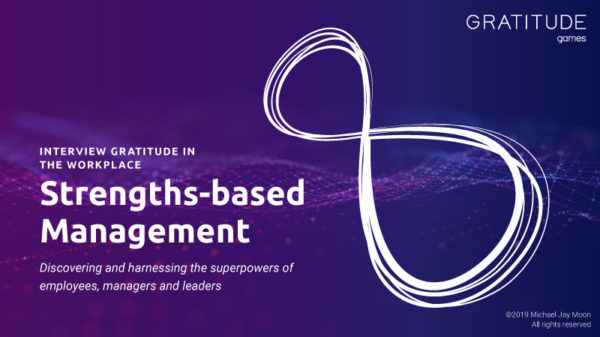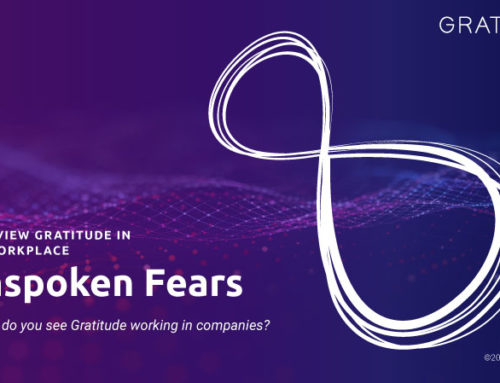In my work with small business owners and startup founders, I have them institute the protocol where managers have one-on-one check-in meetings each employee.
Again, I took the meeting template from Michael Gerber of E-myth, adding something called Character Strengths and Virtues that came from the University of Pennsylvania’s School of Positive Psychology.
The weekly check-in protocol starts a few hours before the actual meeting.
On their own, both the manager and employee review their promised key results from last week, using a trigger list of questions that prompts their Cognitive Unconscious to offer up additional insights and correlations.
The protocol asks them to come ready with a number between 0.0 and 1.0 or a percentage that quantities the level of completion of each key result.
Trigger questions also prompt them to discuss an intervening issues that may have hindered their success.
The protocol also asks them also come prepared with a set of new key results for the next week, ready for discussion and maybe some negotiation.
With all that fresh in their minds, the meeting begins with a quick emotional check-in (Meet protocol), followed by the manager asking seven or so questions and the employee talking more than 90 percent of the talking.
Right there, that 90/10 split makes this the employee’s meeting and not the manager’s meeting.
Seven Trigger Questions for Weekly Check-ins
These questions are:
What’s the best thing that happened around here?
Asked week and week, this cues neurocircuitry of the brain to find retrospectively and, then later, proactively index that good things happen.
What are a few other good things that happened over the last seven days?
This not only reinforces that good things are happening.
In a firm, gentle and persistent way, it prods them to re-index the week’s proceedings and see them in a more positive, affirmative perspective.
Over time, this will surface and begin dissolving negative or unproductive beliefs, and installs new, healthier and productive habits.
What’s something that needs improving around here?
This gives the employee about 45 or so weekly opportunities each year to complain about anything.
Just that knowing that you can complain gets the ball rolling in the right direction.
Complaints often fall into a few basic categories, such as interpersonal issues, physical or digital barriers to getting something done, too much work / need for improved prioritization, etc.
However, the one that I want to highlight here deals with a weak or missing systems or protocols.
So, as laid out in the position agreement and reinforced in monthly business review meetings, the manager invokes the Needed Solution Protocol.
This asks the employee if he or she would research the problem and propose a solution to the team or group.
The Needed Solution Protocol can produce a huge, immediate improvement, especially in chaotic startups or in high growth situations.
I also recommend the use of a natural planning protocol from David Allen, which provides a set of trigger questions to ask at the stages of brainstorming, action planning, and team assignments.
This protocol flips the narrative of complaint and powerlessness to one of agency, choice and power.
The Needed Solution Protocol can also provide one of the keystones in performance-based compensation of employees, paying them performance bonuses based on the economic value-added or business-case performance of the newly implemented AND documented business capability.
With respect to last week’s Key Results, what did you consider in assigning those completion percentages?
The foreknowledge of having to justify the percentage of key result completions sets in motion a number of good things. However, I’d like to focus on three.
One, in finalizing a key result to achieve, the Weekly Key Results Protocol asks the employee (or executive!) to index the levels of DIFFICULTY and CONFIDENCE for each Key Result, using a scale of 0.0 to 1.0 or zero percent to 100 percent.
Week after week, this will eat away at something called the Planning Bias or the consistent underestimation of the work required and a deeper appreciation of various interdependencies of a growing firm.
As a result, they become more realistic about what it takes and more successful in getting it done.
Two, consistent inspection and summarization should lead to an OKR Roll-up.
OKR Roll-ups work like a daily close of the financials, only the OKR Roll-up dashboard aggregates all of the micro-progressions across the organization, shines on light on critical dependencies (key people going on holiday, traveling, etc.), and highlights those areas needing support or deserving of kudos with a note from the CEO or COO,
Hey, you’re crushing it. Thanks for
taking us to the next level!
You can prototype OKR Roll-up dashboard in Airtable or a Google Sheet, starting small and moving fast and using a more formal tool later.
There, both employee and manager can see in the correlation of the level of difficulty and confidence, indexing whether or not the Key Result is too aggressive or too easy.
Now there’s a whole lot more to that discussion, including issues of scale, sequence or prerequisite foreknowledge.
However, tweaking the tension between difficulty/effort and confidence/ease enable the employee and manager can make the game both novel and challenging without it becoming total pain in the rear.
With respect to last week’s Key Results, with what did you struggle? Discover? Learn?
There’s also an art of unpacking this. It probably takes a few years of experience plus a book or workshop to really understand this a comprehensive way.
However, I’d like to address three things.
First, it really helps if both employee and manager share a general theory of organizational change, especially if adapted to high growth-potential startups, successful startups now grappling with high rates of growth, or firms amidst some sort of high-stress turnaround.
And by that, the employee and manager share an understanding that the current situation represents a dynamic equilibrium of forces that facilitate and hinder change.
That most positive organizational changes evolve in small steps and that the mindset of constant tweaking or evolution keeps the organization limber and resilient.
Second, it really helps if both employee and manager agree to play a game with protocols for Organizational Transparency, Heartfelt Candor and Thoughtful Feedback – behavioral standards that everyone had agreed to follow when they joined the company and signed their position agreement.
Organizational Transparency constitutes a set of behaviors that by default disclose the facts at hand with the shared agreement to first establish the facts before interpreting them or taking action.
The motto Organizational Transparency might be expressed as
It’s always better to know,
then not know, and
sooner rather than later
Heartfelt Candor are a set of behaviors for first feeling the fullness, sting and all, of an interaction or communication with another. That’s the opposite of reacting in the red-hot moment.
This behavioral standard asks you to frame your feelings as having an experience, as in I have the feeling of anger, as opposed to self-identifying with the sharp remark, I am angry about …
And, once you have taken the hit so to speak and allowed your observed reactions flow through you, you can then communicate your experience, how it made you feel, and the facts as you know them.
Thoughtful Feedback starts with the permission to provide feedback with the stipulation that both of you will focus on facts in evidence, what happened, when, where, and sequences.
From there you offer multiple possible interpretations and, with the agreement, offer a range of potential actions towards a solution.
This underscores a shared curiosity about multiple perspectives and a love of learning which one or which combination of perspectives best fits the facts in evidence and the mission, vision, and objectives of the firm.
Thoughtful Feedback also comes with the shared recognition of which particular perspective will produce the best results for the company, customers, and employees.
Third, the weekly check-in meeting will reveal the first signs of drift, misalignment, or deteriorating character/job fit.
Again, there’s a whole workshop or wisdom of a career in how to conduct this discussion.
But, then again, you learn by doing. You’ll never get it right all the time. And you’re never really done.
However, weekly check-in meetings are a great place to pull out the Relational Strengths Placemat (which I’ll get into that in a bit) to gain new perspectives almost every time, accelerating deeper insights and persistent biases that both manager and employee bring to the table.
What do you propose for key results of next week with your best estimates of difficulty and confidence?
Here employee and manager co-create together. The employee will propose. They will then debate, resolve and commit to the achievement of three or so key results for the week.
Again, I’d like to highlight two aspects.
First, it’s crucial that each result conform too, ensuring that each goal is Specific, Measurable, Achievable, Relevant, and Time-bound.
Second, it’s important to counter that common habit of starting an activity as a goal.
I have found outcome-based thinking (nod to David Allen of Getting Things Done) works great.
This means thinking in terms of producing a result that makes a difference to the business.
Most often this also means producing something and then handing it off to another person who will determine its value or utility and indicate their satisfaction with it.
Typically, problems spring up when employees never knew or made the effort to understand the conditions of satisfaction for their work products.
Here the manager, often with more experience and a larger inventory of cause-effect relationships can provide needed facets or alert the employee to dig deeper into the conditions of satisfaction that their weekly key results must satisfy.
Given all that’s gone on around here, about whom are you grateful and willing to let know?
While this speaks for itself, you know, expressing your gratitude to someone, a colleague or customer, there’s a lot more to this than a simple gesture.
Expressing your gratitude on a regular basis establishes a social norm, like coming to work with clean clothes and not wreaking with body odor.
Expressing your gratitude cues the neurocircuitry of brains to become aware and accepting of the Presence of others … you know, about which to have gratitude.
Expressing your gratitude activates parts of the brain that make you more empathic, intuitive, creative, and collaborative.
Expressing your gratitude deepens a shared awareness of our interconnectedness and offsets the our more fear-based, me-first tendencies … always a good thing for high-performing teams.
Expressing your gratitude begets more Gratitude, cuing your neurocircuitry to index for it and thus seeing it no longer hiding in plain sight. This primes a virtuous cycle that with consistent reinforcement becomes a self-generating system with its own inertial momentum
As gratitude begins to compound, it induces a greater sense of well-being, of having more than enough as well as a greater willingness to share that bounty.
Finally expressing your gratitude creates a pervasive environment within the firm and through it external relationships, drawing the best and most loyal customers and future employees to firm.
So, these seven or so trigger questions, posed and answered week and after week, transform the Weekly Check-in from management brow-beating sessions into a game of mutual strengths.
I believe that the protocols for the Weekly Check-in can, with deliberate practice and inspection, become a mechanism of culture and engine of transformation.



